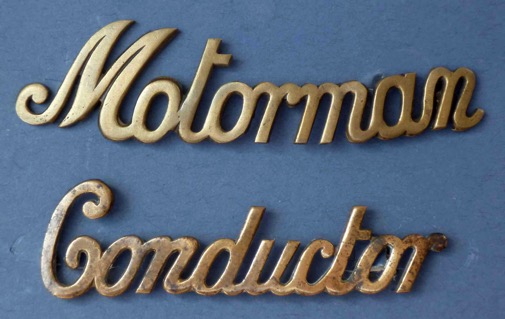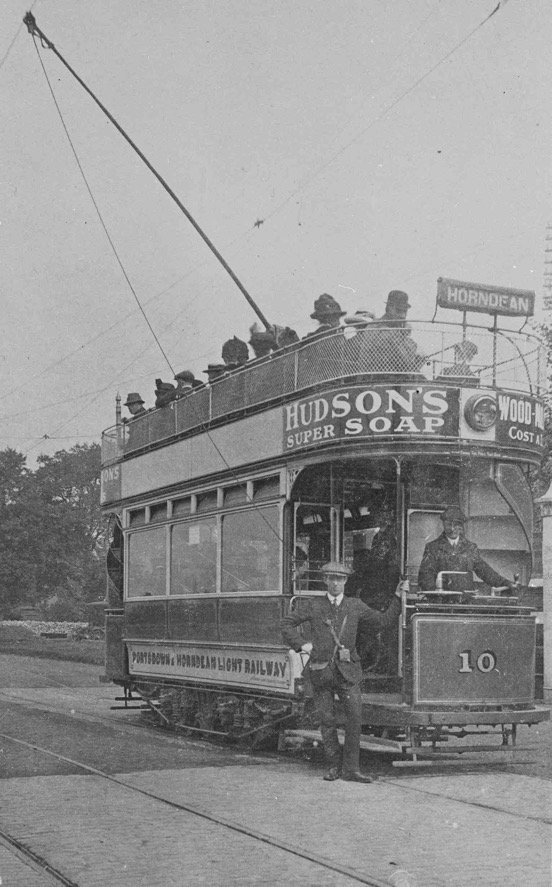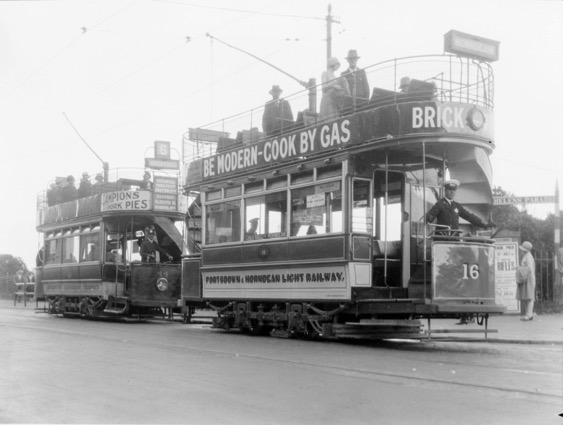Portsdown and Horndean Light Railway
History
In the 1890s, various figures in Portsmouth Borough began to agitate for the town's horse tramways to be taken into municipal ownership, and to convert them to electric traction. The tramways in question were all operated by the Portsmouth Street Tramways Company, a subsidiary of the Provincial Tramways Company. The PTCo was a London-based holding company that had been founded in 1872, and which would ultimately be involved in tramway operation for over fifty years, either owning, controlling or operating: the Borough of Portsmouth, Kingston, Fratton and Southsea Tramways; Cardiff Tramways; Cardiff District and Penarth Harbour Tramways; General Tramways of Portsmouth; Gosport Street Tramways; Gosport and Fareham Tramways; Great Grimsby Street Tramways; the Landport and Southsea Tramway; London Southern Tramways; Plymouth, Stonehouse and Devonport Tramways; the Portsdown and Horndean Light Railway; and Portsmouth Street Tramways.
By 1897, it had become clear to the PTCo that it would lose all its Portsmouth-area tramways to Portsmouth corporation (by compulsory purchase), so it started to turn its thoughts to the future, forming a subsidiary — the Hampshire Light Railways (Electric) Company — on the 7th May 1897, to build and operate electric tramways to the north of Portsey Island.
On the 2nd September 1898, the company obtained a Light Railway Order to build just over 6 miles of electric tramway between Cosham – where it would connect to the corporation's system – and Horndean. The tramway was authorised by the Portsdown and Horndean Light Railway Order, 1898. The gauge was simply stated to be the same as that selected by Portsmouth Corporation, which then led to a delay, as the latter was undecided, though it eventually chose to stick with the gauge of the horse tramway, namely, 4ft 7¾ins.
Although Portsmouth Corporation eventually took over the PTCo's Portsmouth horse tramways at midnight on the 31st December 1900, the deal had not exactly been a smooth one, with disagreements on exactly what should be included in the handover, as well as the price. As part of the settlement, however, the corporation agreed to a connection being made with the as-yet-unbuilt P&HLR, but also secured running rights for corporation cars over P&HLR tracks to the top of Portsdown Hill, a step both parties would come to regret.
Construction finally commenced in January 1902, 5.94 miles of the authorised 6.03 miles being constructed. From an end-on junction with the PCT system in Portsmouth Road, the line ran northeastwards to Horndean via a private formation, over the railway and up Portsdown Hill, where it joined London Road, running through Widley, Purbrook, Waterlooville and Cowplain, to a terminus at the top of Horndean Hill. Although powers for an extension of three furlongs were granted by the Light Railway Commissioners on the 13th February 1908 – under the Portsdown and Horndean Light Railway (Extensions etc.) Order 1908 – this does not appear to have been built.
The overhead electric tramway opened for business on the 2nd March 1903, passengers from Portsmouth having to arrive via PCT horse trams, as the new Ports Bridge was not ready, preventing the heavier electric cars from proceeding north beyond it to Cosham. The corporation electric services finally reached Cosham just over one month later on the 18th April 1903, through running up Portsdown Hill commencing the following month. The latter turned out to be a waste of everyone's time, a huge number of services running up the hill empty (for which the company had to make a contribution, and provide electricity), as passengers could just as easily change to a P&HLR beforehand. After much too-ing and fro-ing, through running was finally abandoned on the 30th June 1907, no doubt much to the relief of the company.
The services were operated by 16 tramcars, 14 arriving during 1903, and 2 more in 1905.
The relationship between the PTCo and the corporation was initially fraught, not just because of the Portsdown Hill situation, but also the exorbitant charges that the corporation made for supplying electricity to the tramway. The latter was certainly making a handsome profit at the expense of the company, which was paying significantly more for its electricity in total than the corporation's own system, which was three times larger, with a greater service intensity. Quite why the company had agreed to the rates in the first place is unclear, but with the corporation refusing to budge, the inevitable happened, the company taking the decision to generate its own electricity. In March 1907, with the completion of its power station approaching, the company decided to close down the system completely rather than keep paying the exorbitant charges. Both bones of contention were, however, soon removed, the latter by the opening of the company's power plant on the 1st July 1907, and the former by the creation of a PCT interchange loop adjacent to the PHLR at Cosham (in late summer the same year).
Little is known of the tramway's financial affairs, or the situation that prevailed during the Great War.
By 1923, both the PCT and the P&HLR were suffering competition from the motorbuses of Southdown Motor Services, which finally led to an agreement between the two tramways on through-running of P&HLR cars into Portsmouth. The first services, through to Portsmouth Town Hall, began on the 1st August 1924; they were extended later that year to Palmerston Road and to Clarence Pier in 1925, and ultimately, in 1927, to South Parade.
In 1930, seven second-hand tramcars arrived from Gosport and Fareham Tramways — a sister PTCo tramway that had just closed — which led to the withdrawal of four of the existing fleet.
By early 1934, it was becoming clear that the PCT would soon abandon its tramway system completely, replacing the tramcars with trolleybuses. The company, seeing which way the wind was blowing, offered the tramway to the corporation, but was rebuffed. In October, however, abandonment gathered pace, first of all with the withdrawal of regular PCT tram services north of North End (on the 1st October 1934), leaving the P&HLR as the sole operator over this section, which was followed two days later, by formal notification (to the corporation) of the company's intention to cease through running in three months' time. The latter was the result of an offer for the tramway by Southdown Motor Services, which was no doubt hurriedly accepted.
The Portsdown and Horndean Light Railway ran its last tramcar service on the 9th January 1935, bringing to an end almost thirty-two years of tramway operation.
Uniforms
Photographs of P&HLR staff taken prior to the Great War are extremely scarce, but those that do exist indicate that staff wore double-breasted jackets, with four pairs of buttons, and lapels, the style being very similar to that worn by their Portsmouth Corporation Tramways counterparts during the first decade of that system's life (see link). The collars, cuffs and trousers were all piped in a lighter colour than the main body of the jacket. The bearer's right-hand collar bore system initials in individual metal letters, probably either 'P & H L R' or 'P H L R', the left-hand side an employee number. The tensioned-crown peaked caps bore script-lettering grade badges, either 'Motorman' or 'Conductor'. It is unclear whether the insignia were brass or nickel. Although lighter, more modern materials were used in later years, the basic style of the jacket remained unchanged.
Tramcar crews were also provided with double-breasted greatcoats with high, fold-over collars; these do not appear to have borne any insignia.
In later years, staff wore large round municipal-licence badges; these were almost certainly introduced in 1924 when through running over PCT metals began; this was in marked contrast to corporation staff, who had not worn licence badges since the introduction of numbered cap badges in 1916.
The 1903 photograph below shows an inspector wearing a single-breasted jacket with lapels, along with a matching waistcoat; both garments appear to have been made of corduroy, and were without badges of any kind. His tensioned-crown peaked cap bore a script-lettering grade badge 'Inspector', probably made of metal rather than embroidered on a hat band. The style of uniforms worn by inspectors in later years remains unknown.
The P&HLR employed female staff during the Great War to replace men lost to the armed services, however, photographic evidence is completely lacking, so details of their uniforms remain unknown.
Further reading
For a history of the area's tramways, see 'Tramways of Portsmouth' by S E Harrison, Light Railway Transport League (1955).
Images
Motormen and conductors
A staff photograph taken at Cowplains Depot in 1903. With the exception of an inspector, all those wearing uniforms are conductors, motormen presumably being those wearing informal attire. Photo with kind permission of Hampshire County Council (see link).
An enlargement of the above photograph showing four of the youthful looking conductors; their right-hand collars bear system initials ending in 'R', so presumably either 'P & H L R' or P H L R'. Their caps carry standard, script-lettering grade badges.
Standard off-the-shelf script-lettering grade badges of the type used by the Portsdown and Horndean Light Railway on tramcar-crew caps; it is unclear whether they were issued in brass or nickel. Author's Collection.
Tramcar No 10 pictured with its crew at Cosham – photo undated, but believed to have been taken in the late-Edwardian era. Photo courtesy of the National Tramway Museum. 
An enlargement of the above photograph showing the crew, including Conductor Fred Ansell, who was born in 1890, and looks to be about twenty years old here, indicating that the photograph was taken around 1910. Why both men are wearing informal attire, circa seven years after the system opened, is unclear. Fred Ansell is recorded as a Tramcar Conductor in the 1911 census, as a Tram Driver in the 1921 census, and as a bus conductor in 1939.
Tramcar No 14 pictured at the terminus at Horndean. Although undated, the photograph must have been taken between 1924, when Portsmouth licence badges were first worn, and 1930, when the first No 14 (pictured here with reversed staircases), was replaced by a second-hand No 14 from Gosport and Fareham Tramways (with direct staircases). Photo courtesy of the National Tramway Museum. 
An enlargement of the above photograph showing the motorman, Bill Iveston. His jacket appears to bear dark-coloured buttons, either coated metal or black horn.
Tramcar No 13 stands with its crew at the terminus at Horndean in 1929. Photo courtesy of the National Tramway Museum. 
An enlargement of the above photograph showing the crew, Conductor Newland and Motorman Tim Smith. Both men are wearing Portsmouth Licence badges on the left breasts. Once again, the crew's jackets appear to bear dark-coloured buttons.
P&HLR Tramcar No 16 stands in St Helens Parade Portsmouth, along with Portsmouth Corporation Tramways Car No 44 — photo undated, but certainly taken no earlier than 1927 when through running of company tramcars to this destination commenced, and possibly as late as 1930. Photo probably by Dr H Nicol, with thanks to the National Tramway Museum. 
An enlargement of the above photograph showing the motorman, who is wearing a large round municipal licence badge, very possibly identical to those previously worn by corporation staff before their displacement by numbered cap badges in 1916. With thanks to the National Tramway Museum. 
The crew of Tramcar No 16 at the Canoe Lake/Granada Road terminus — photo undated, but probably taken in the early 1930s. Photo by H Nicol, courtesy of the National Tramway Museum. 
An enlargement of the above photograph showing the conductor and the motorman (the latter inside the car). 
Motorman George Wells and his conductor pose for the camera on the platform of what is possibly Tramcar No 20, at South Parade Pier in Portsmouth on the 6th January 1935. Motorman Wells' Portsmouth licence badge is just visible, protruding from the top right of his heavy-duty leather apron. Photo believed to have been taken by G A Tucker, courtesy of the National Tramway Museum. 
An enlargement of the above photograph showing the conductor. He would appear to be wearing a uniform jacket, along with light-coloured trousers, a combination often used by bus companies of the time. He is also wearing a PSV licence badge on his left breast pocket, which strongly suggests that he was a bus conductor, presumably filling in on the tramway. Given the shape of his cap badge, he was very probably an employee of Southdown Motor Services, which had taken over the tramway and which closed it three days later.
An early Southdown Motor Services cap badge of the type worn in the above photo. Photo courtesy of the Stephen Howarth Collection.
A photograph taken by Herbert Marshall at Cowplain depot to mark the end of tramway operation on the 9th January 1935. The man at the controls is Motorman Tim Smith, the man with the pipe is the depot foreman, Mr Mitchell. The uniformed tramway men are all wearing tensioned-crown peaked caps bearing script-lettering grade badges, along with greatcoats that appear to be completely devoid of insignia. Photo courtesy of the National Tramway Museum.
Senior staff
An enlargement of the 1903 staff photograph above showing the inspector, in what would appear to be a corduroy jacket and waistcoat.
Script-lettering 'Inspector' cap badge — brass. It is unclear whether the cap badges issued by the P&HLR would have been nickel or brass.
A photograph of a tramcar crew in informal attire, together with a man (on the right) who is very probably an inspector – photo undated, but possibly taken shortly before the Great War. Photo courtesy of the National Tramway Museum.